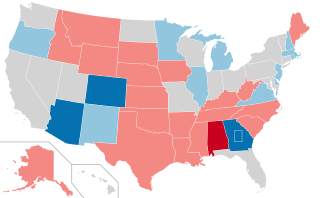2020 United States Senate elections facts for kids
|
|||||||||||||||||||||||||||||||||||||||||||||||||||||||||||||||||
|
35 of the 100 seats in the United States Senate 51 seats needed for a majority |
|||||||||||||||||||||||||||||||||||||||||||||||||||||||||||||||||
|---|---|---|---|---|---|---|---|---|---|---|---|---|---|---|---|---|---|---|---|---|---|---|---|---|---|---|---|---|---|---|---|---|---|---|---|---|---|---|---|---|---|---|---|---|---|---|---|---|---|---|---|---|---|---|---|---|---|---|---|---|---|---|---|---|---|
|
|||||||||||||||||||||||||||||||||||||||||||||||||||||||||||||||||

Results of the elections:
Democratic gain Republican gain Democratic hold Republican hold Result undetermined No election Rectangular inset (Ga.): both seats contested |
|||||||||||||||||||||||||||||||||||||||||||||||||||||||||||||||||
|
|||||||||||||||||||||||||||||||||||||||||||||||||||||||||||||||||
The 2020 United States Senate elections were important events where people voted for their representatives in the United States Senate. These elections happened on November 3, 2020. Voters chose 33 new senators to serve a six-year term, starting from January 3, 2021, until January 3, 2027.
Two special elections were also held on the same day. One was in Arizona because Senator John McCain had passed away. The other was in Georgia because Senator Johnny Isakson had resigned. These special elections helped decide who would fill those empty seats.
Contents
What is the US Senate?
The United States Senate is a very important part of the U.S. government. It is one of two parts of the United States Congress, which makes laws for the country. The other part is the United States House of Representatives.
There are 100 senators in total, with two senators from each of the 50 states. It does not matter how big or small a state is, they all get two senators. Senators serve for six years.
How Senate Elections Work
Senate elections happen every two years. However, not all 100 senators are up for election at the same time. Instead, about one-third of the Senate seats are voted on every two years. This means there are always experienced senators in office.
In 2020, 33 regular Senate seats were up for election. These seats are divided into three "classes," and each class has its election in a different year. The 2020 elections were for "Class 2" senators.
Special Elections Explained
Sometimes, a senator might leave office before their six-year term is over. This can happen if they resign, retire, or pass away. When this happens, a "special election" is held to choose someone new to finish the rest of their term.
In 2020, there were two special elections:
- Arizona: A new senator was chosen to fill the seat left empty by John McCain. A Democrat won this seat, which was previously held by a Republican.
- Georgia: Two special elections were held in Georgia. Both seats were won by Democratic senators. This changed the balance of power in the Senate.
Key Results of the 2020 Elections
Before the 2020 elections, the Republican Party had more seats in the Senate. They had 53 seats, while the Democratic Party had 45 seats, and two senators were independent.
After all the votes were counted, including the special elections in Georgia, the number of seats changed:
- The Democratic Party gained 3 seats, bringing their total to 48.
- The Republican Party lost 3 seats, bringing their total to 50.
- The two independent senators kept their seats.
What Changed in the Senate?
The biggest change happened in Georgia. Both of Georgia's Senate seats were won by Democrats. This meant that the Senate became evenly split, with 50 Republicans and 50 Democrats (including the two independents who usually vote with the Democrats).
When the Senate is tied 50-50, the Vice President of the United States has the power to cast the tie-breaking vote. After the 2020 elections, the Vice President was a Democrat. This meant that the Democratic Party gained control of the Senate.
Before the elections, Mitch McConnell (a Republican) was the Majority Leader. After the elections, Chuck Schumer (a Democrat) became the Majority Leader. The Majority Leader is the main leader of the party that controls the Senate.
Images for kids
See also
 In Spanish: Elecciones al Senado de los Estados Unidos de 2020 para niños
In Spanish: Elecciones al Senado de los Estados Unidos de 2020 para niños




